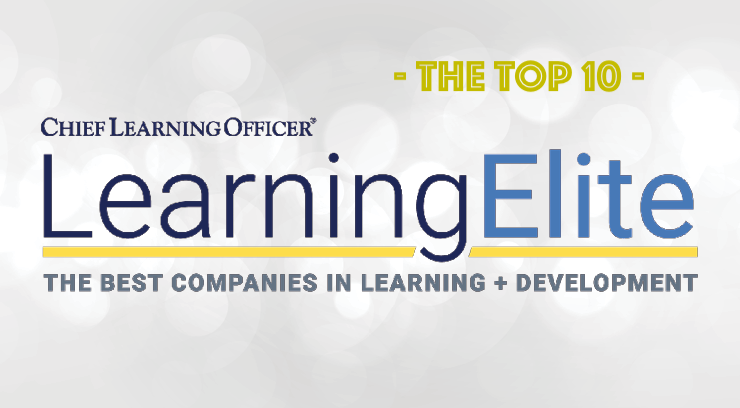
The Department of Veterans Affairs’ Office of Information and Technology placed No. 10 in Chief Learning Officer’s 2021 LearningElite program. Here’s how VA leaders and the training team have fostered a culture of learning that transcends COVID-19.
by Sarah Fister Gale
October 26, 2021
The Department of Veterans Affairs has one important advantage when it comes to creating a world-class learning organization. “All of our employees are passionate about our mission,” says Angela DeSarro, chief learning officer in the Office of Information and Technology and director of IT workforce development.
The core mission of the VA is to care for veterans and their families. The talent management office makes sure all of its 377,805 employees have the technological skills they need to make that mission a reality.
“We align our strategy to today’s needs but also analyze needs up to 10 years out to be ready for tomorrow,” DeSarro says. “If we need to reprioritize, as was the case during COVID, we do it quickly and effectively, especially for a federal agency of our size.”
The OIT’s commitment to its mission and future-focused approach to training is why it placed No. 10 among this year’s LearningElite.
DeSarro attributes much of her learning organization’s success to the fact that senior leaders see them as a strategic element of the VA. “Through negotiation and leadership we have established ourselves as partners at the table,” she says. Her team regularly meets with senior leaders to discuss what skills are required to maximize the VA’s impact on its mission. “They provide critical guidance to identify current and future learning needs … and to drive learning participation.”
That leadership support and the collaborative relationship between leaders and the learning organization is what makes the culture of learning so strong, she says. “From serving as guest speakers to creating welcome videos for programs, our executives help drive a learning culture.”
Competency is part of the culture
At the core of the OIT’s learning program are 30 role-specific competency models that provide a “streamlined, data-driven approach” to professional development. The models include everything from leadership and foundational skills to specific technical competencies, including cloud computing and network and database management.
The customized models identify a common set of focus areas for role-specific skills and abilities and establish a baseline to assist employees in their ongoing professional development. The models also provide a foundation for discussions between managers and individuals to set development goals, and to create a custom training plan.
Each employee’s competency is measured based on their proficiency (from novice to expert), experience (entry- to senior-level) and functional expertise. Employees are aligned to the profile that best represents their role, and that alignment is reviewed annually.
To ensure the competencies remain relevant, DeSarro’s team conducts annual assessments in collaboration with leadership and SMEs to identify and make changes to roles, skills or priorities. They also regularly collaborate with end users, talking with them about the challenges they face and what training will help them improve the job, then fine-tune the learning strategy to best support them.
As part of this collaborative approach, the OIT’s talent development team is embedded throughout the organization so they can constantly watch for learning needs and calibrate resources to make the biggest impact. When they identify a gap, the team works together with staff to determine what the skill gap is, why it’s occurring and how to close it as efficiently as possible. “Getting feedback from end users and senior leaders helps us develop tailored training to meet their specific needs,” DeSarro says.
They also constantly monitor conversations, meetings and requests throughout the year to proactively identify changes that need to be addressed. “Changes can include new competencies, updated definitions and recalibrated targets,” she says.
When these observations uncover the need for an entirely new role, her team follows a systematic process for identifying or defining competencies and proficiency targets, then aligning key staff and training to these roles. For example, in 2020 her team added “automated testing” and “automated security” to the competencies in response to a DevSecOps workforce development needs analysis and a Cyber Training Academy to focus on the portability of cyberskills during the pandemic.
This approach helped her team rapidly stand up the new Office of Strategic Sourcing to lead aggressive modernization in procurement/acquisitions. “Leveraging our best practices, we defined six unique strategic sourcing role profiles with SMEs and leadership to facilitate consensus,” she says.
Cue the green screen
When new course needs are identified through any source, a team of instructional designers use Agile development methodologies to build training that can be delivered across various modalities to support all learners. This agility and multichannel approach was key in helping the VA pivot its learning strategy during the pandemic.
Prior to COVID, the OIT workforce development team offered learning opportunities through a variety of channels, including strategic learning events, in-person training, live broadcasts, and classroom and self-paced training tied to industry-recognized certifications. When the pandemic required employees to work remotely, DeSarro’s team ensured learning remained accessible by leveraging a virtual learning platform so all staff could continue to engage with whatever content they needed to remain productive.
As a federal agency, the organization can only use “approved” technology, and DeSarro’s team has been a leader in leveraging the suite of options to their full advantage. The VA was an early federal adopter of The Virtual Learning Campus, and they were among the few agencies to fully virtualize training due to COVID.
For live events, they modified four recording studios with green screens, implemented virtual breakout rooms, and added social engagement specialists to moderate, respond to and triage live participant input from virtual learners. “Within just a few weeks, the campus was running in 100 percent remote mode,” DeSarro says.
Leaders embrace virtual learning
Some VA leaders were initially skeptical that the workforce could be engaged in a remote environment, but they quickly shifted gears when they saw how engaging the virtual events could be. Now DeSarro says leaders are eager to participate as speakers, coaches and content advisers. “They send notes to me asking what else they can do with the platform.”
One of the biggest successes in the shift to virtual were the outreach events featuring leaders speaking to staff and answering questions. “In total, 83 live and 63 recorded events were supported with a total of 85,235 instances of participation,” she says. They’ve been so successful that other federal agencies have begun asking for her team’s help in transitioning their own learning environment.
As she looks to the future, DeSarro’s next big goal is to tackle succession planning by providing rising leaders with mentors and opportunities to expand their skills. “There is a wealth of informal knowledge at the VA,” she says. By linking high performers with senior staff, she hopes to bridge the knowledge transfer gap and create a powerful bench of leaders to deliver on the VA’s mission in the future.




